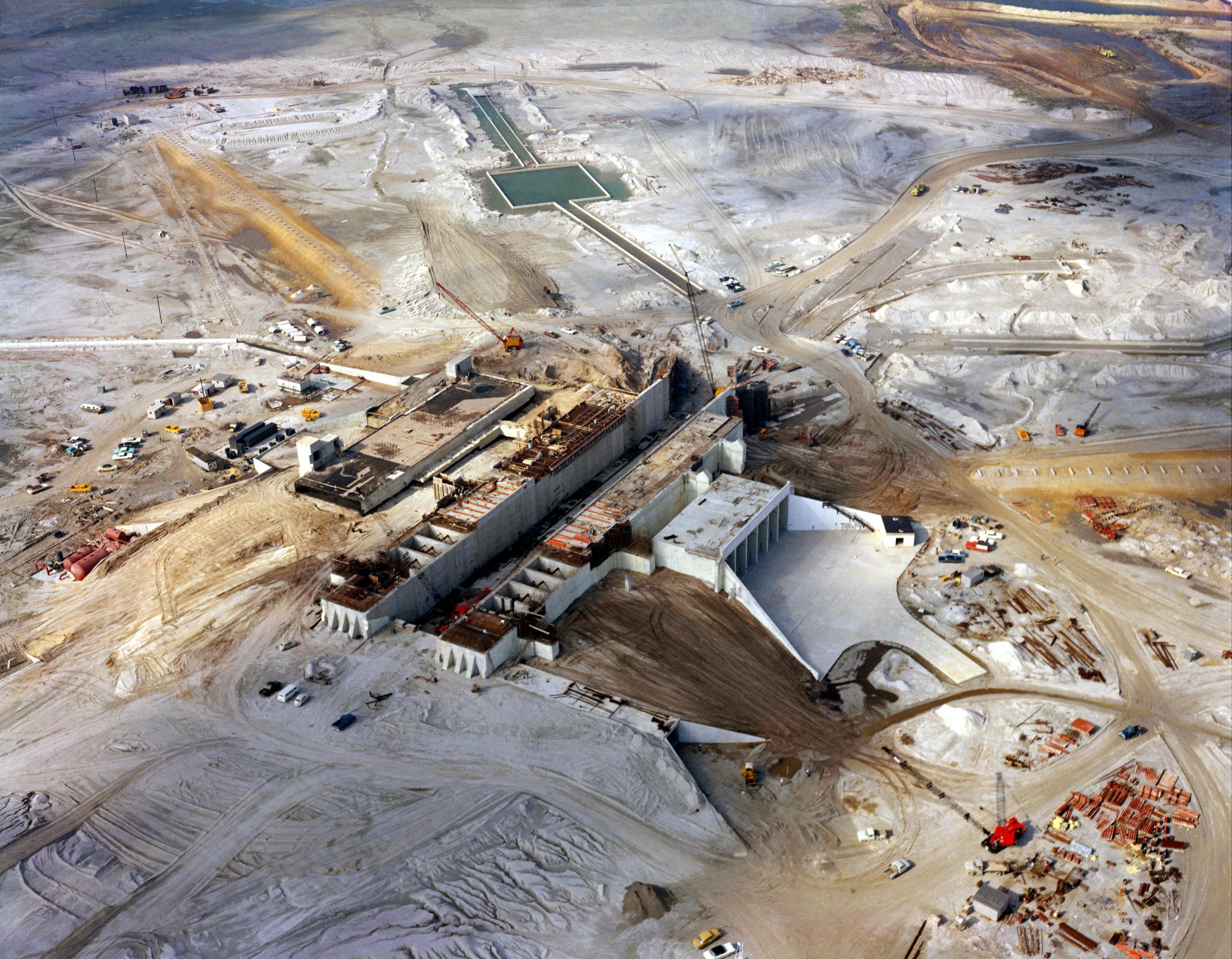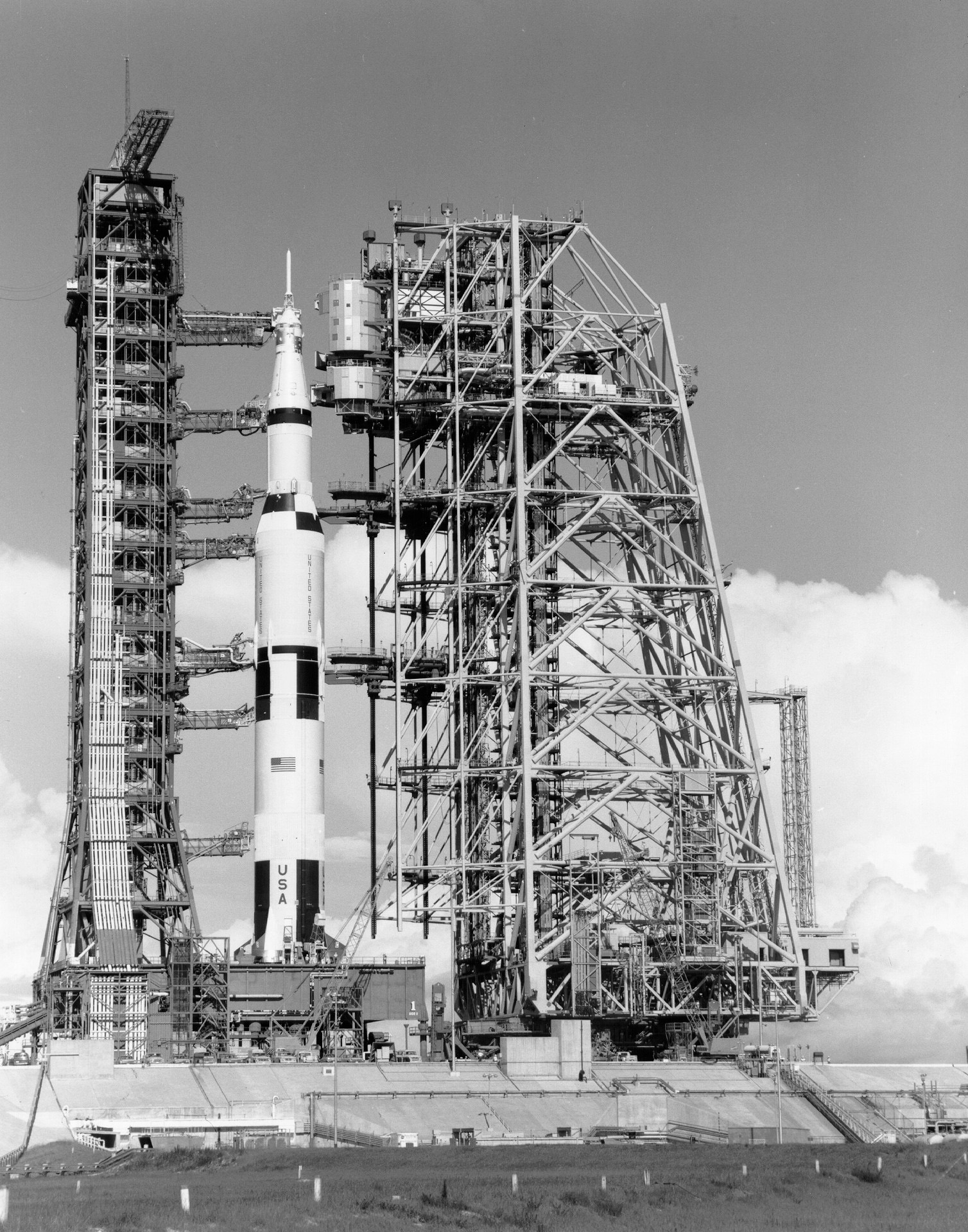
The iconic launch pads, Pads 39A and 39B at Kennedy Space Center’s Launch Complex 39, have been the starting point for many space flights including the first manned lunar landing. The original design for Launch Complex 39 called for three to five launch pads, designated 39A – 39E, that would have been spaced approximately 1.6 miles apart to protect them from damage if any mishaps occurred at an adjacent pad. Also part of Launch Complex 39 is the Vehicle Assembly Building, or VAB. Towering more than 500 feet, it can be seen easily from miles away. The Launch Control Center, or LCC, where all the launch controllers, support personnel, and equipment required to safely launch a vehicle from either of the launch pads is also a part of the large complex.

Aerial view of Launch Complex 39A during construction in the 1960s. Credit: NASA
PAD 39A FROM SAND TO APOLLO
Pad 39A was originally designated to be Pad 39C in the complex’s original plan, however it became 39A when plans to build the three additional pads were scrapped in 1963. Launch Complex 39’s A pad was completed first. Construction began in November of 1963 and was completed in early September 1965. Built on around a quarter square mile of land, the launch site is an eight sided polygon and measures 3,000 feet across. The pad itself is 390 feet by 325 feet and is constructed of reinforced concrete. The hardstand stands 48 feet above sea level. To get from sea level up to the hard stand, a five-percent sloped ramp was constructed. Which raises the question, “Why build up and not down to avoid having to have a ramp up to the pad?”. The answer is simple, the pads are located in Florida just a quarter mile away from the Atlantic Ocean, and digging down just a few feet you will encounter water. So to protect all the equipment and facilities that are under the pad, the decision to build above ground was made.

Aerial views of Launch Complex 39A during construction in August of 1965. Credit: NASA via Retro Space Images.
For Apollo, the pad would be a clean pad, no structure, towers, or other support equipment was located on top of the pad. All these items would be brought with the vehicle. The vehicle was assembled on a massive platform known as a Mobile Launcher. On the Mobile Launcher was a Launch Umbilical Tower (LUT) and a mobile service structure which allowed for crew access, all the umbilical connections for the rocket, elevators, service platforms, everything you needed to get the vehicle ready for launch on the pad. The Mobile Launcher was transported by a new vehicle, called the Crawler, from the Vehicle Assembly Building out to the pad. The Mobile launcher would be lowered onto pedestals located atop the hardstand.
Without the Mobile Launcher at the pad, from the outside mostly what you see at Pad 39A is the pad itself, however much more lies beneath the exterior. A two-story pad terminal connection room which houses all of the electronic equipment that would connect the Launch Control Center with the Mobile Launcher when it’s on the pad, is located on the western side of the pad. Also on the same side is the environmental control systems room which supports the air conditioning and water systems. Beneath the east side of the pad is the high-pressure-gas storage facility, where nitrogen and helium gases piped from the converter-compressor facility would be distributed from. Dissecting the east and west sides is the 58 foot wide, 450 foot long, Flame Trench. A Flame Deflector, weighing some 700 tons, would be rolled into place via a rail system in the Flame Trench until it was just under the rocket. The deflector directed the flames down the trench and away from the vehicle and pad.

Aerial view of Launch Pad 39A during the Apollo/Saturn era. Credit: NASA
Also located inside of the pad area is a blast room. If a hazardous condition came up that required the Apollo Astronauts to egress from the spacecraft, they would move from the spacecraft back to the Mobile Launcher’s tower and ride the high speed elevator down 30 stories, in about 30 seconds. Then they would slide down an escape tube to the blast room. The blast room has thick steel doors which could withstand the explosion if the vehicle erupted on the pad. The crew could survive for at least 24 hours in the blast room until they could be rescued.

A Saturn V rocket atop Launch Pad 39A with the fixed and mobile service structures in place. Credit: NASA
The first flight from Pad 39A would be Apollo 4, an unmanned test of the great Saturn V rocket. Following it would be another unmanned test, Apollo 6. The third launch was the historic first trip to the moon, Apollo 8, which took Frank Borman, Jim Lovell, and Bill Anders on a trip to the moon where they did 10 orbits before coming back to Earth. And the fifth launch from Pad 39A would be Apollo 11, the first manned Lunar landing when Neil Armstrong and Buzz Aldrin became the first human beings to step on another space body. Pad 39A would be the starting point for every Saturn V mission except for Apollo 10 which launched from Pad 39B. Twelve flights of the Saturn V started at Pad 39A and half of them were the manned lunar landing missions. The pad’s significance as a historical landmark will never be in question due to the fact the first manned landing missions to the Moon all began there. It also served as the launch pad for the Skylab orbiting outpost – our first space station – which was also the last flight of the Saturn V rocket and the last mission to launch from Pad 39A for more than six years.

The Apollo 11 Saturn V lifts off with Neil Armstrong, Michael Collins and Buzz Aldrin on July 16, 1969. Credit: NASA

Looking like a giant erector set, Launch Pad 39A underwent major renovation in the 1970s to evolve it from the Apollo era ‘clean’ pad to include more fixed structures to support Space Shuttle launches. Credit: NASA
Read the rest on RocketSTEM.
(Courtesy of Lloyd Campbell from RocketSTEM)









